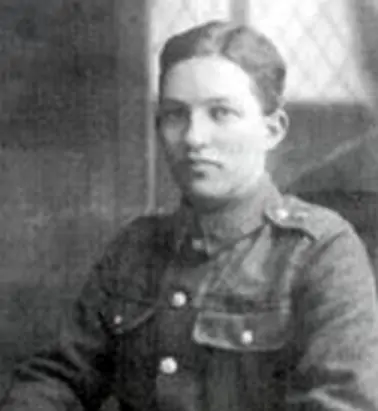
Helen Bennett visited the museum to tell us about Gardner Kennedy.
(William Robert) Gardner Kennedy was my paternal Irish Grandmother’s first cousin. He was the son of Mary and William Kennedy of Ardbana House Coleraine, Northern Ireland. His father had an engineering firm. He was my Irish Grandmother’s cousin. (Annie Morton McMillan of Turnagrove Co Antrim) There is a very strong familial likeness between Gardner Kennedy and his Turnagrove cousins, most of whom I knew.
Gardner Kennedy died on the Swaben Redout on July 1st 1916 which is where his regiment the Royal Iniskilling Fusiliers fought Reg no:18637. Lance Corporal, Machine Gun Corps (Infantry) 1st Battalion Royal Inniskilling Fusiliers.
He has no known grave and is remembered on the Thiepval Memorial, and on the Coleraine War memorial, although on the latter his Christian name is incorrectly spelt. He enlisted on 5th October 1915.
His brother, Lieutenant John Alexander Kennedy, survived the war. However further tragedy struck the family on 2nd March 1917 when the Kennedy family lost their only daughter, Mary Boddie, wife of Geoffrey W Boddie.
Comment:
About 1959 or 1960 I visited Edie Kennedy who (I presume) was Gardner Kennedy’s sister law at Ardbana House, a splendid detached house full of faded elegance. I met Jack, Edie’s son who was a wild child, liked building his own racing cars. Of Edie, I remember only a little old lady, shrunken but lively, sitting regally amongst the faded and cluttered Second Empire furniture in front of a huge fireplace with an enormous glassed domed clock on the mantel piece. The Kennedy family in the past had had money. Of our conversation I remember nothing except, reading my father’s notes, we talked of Irish History.
My father (JD Long OBE) born in 1915 never knew his cousin, but always wanted to keep his memory alive. In later life my father was upset to find that Gardner Kennedy’s name had been last omitted from the Commonwealth War Graves Commission’s Roll of Honour. He asked me to remedy this which I did with pleasure.
We took our children to Thiepval in 1996, and we have visited frequently since. Contrary to my father’s view when he visited Thiepval in the latter years of his life, I found Thiepval, a place of Cathedral – like peace and reconciliation, and the graveyards, places of sadness and of peace.
My husband and I visited the Swaben Redout and the Ulster Memorial two weeks ago. What a mission it was to capture, so many died, so much bravery. Now I know where Gardner Kennedy died and when he is most likely buried.
Not forgotten.

Gardner Kennedy’s medal card

Gardner Kennedy’s name on the Thiepval Memorial
Explore more memories from the ribbon
-
Gertrude Berry
Gertrude was born in 1891, She spent the war as a nurse in the Other Empire Force, Voluntary Aid Detachment, QAIMNS. She was sent straight to France upon joining the Red Cross and from the 9th November 1915 – 8th June 1916 and then 1st July 1916 – 1st August 1916 she was stationed in France. In 1917 she married Harry O ‘Baines. Gertrude was posted from March 1917 until April 1917 at Military Hospital Havant before moving to Catterick Camp in March 1918. This information has been drawn from the Imperial War Museum’s ‘Lives of the First World War’ archive.
-
Sgt Percy Lelliott DCM
Submitted by Ron Taylor, “raised in Shute Road Catterick Camp, moved to Scotton and was schooled in Richmond before wandering around with the forces”……who wanted to tell us about his grandfather, Percy. Percy was born about 1891 in Brighton Sussex, and died 20 September 1967 aged 76. 68703 Bdr Percy Levi Lelliott, enlisted in the 119th Siege Battery, Royal Garrison Artillery, Sussex on 12 Dec 1915. He undertook initial training at Shorncliffe. His unit embarked for France on 5 June 1916, and he fought at the Battle of the Somme. Percy distinguished himself in the field on several occasions by bringing in wounded men under heavy gunfire, sometimes dragging them by his teeth. He was subsequently awarded the DCM. Discharged as Sgt (Acting BSM) 13 February 1919. Percy retired in 1946 after a long career in the Police Force. PC Lelliott received four Commendations from the Watch Committee and local magistrates, two of which referred to rescue operations at Fairlight and Ecclesbourne Cliffs. Retired, Grandpa Percy sat in his Windsor Chair, smoked his pipe and tended his greenhouse.
-
Alfred Myers
Alfred Myers came from a large family in East Cleveland and before the war worked with two of his brothers in the ironstone mines. A member of the Independent Labour Party and a devout Wesleyan Methodist, he played a key role in his local community. He was a tenor in the Wesleyan Carlin How choir, a Sunday school superintendent and trustee of the local church. Myer’s service record survives and records the process of his arrest and sentencing in cold, hard terms. One month after his posting he was arrested and court-martialled. Initially he was sentenced to death but this was commuted to 10 years imprisonment. At his hearing for exemption from compulsory military service, Myers asserted his belief in an international brotherhood of man, and stated that he ‘could not conscientiously kill, nor assist in killing’. But like so many others he was only granted exemption from combatant service and was sent to the Non-Combatant Corps at Richmond Castle. In the cells at Richmond, Myers’s tenor voice was put to good use. With two other conscientious objectors, Brocklesby and Gaudie, he sang the hymn ‘Nearer My God to Thee’ in three-part harmony. Myers’s performance wasn’t as perfect as the other prisoners hoped, however – they had to bang on the cell floor to keep him in time. Following his ordeal with the rest of the Richmond Sixteen in France, Myers was sent first to Dyce Camp, near Aberdeen, and then Maidstone prison. Others of the Richmond Sixteen were also…
